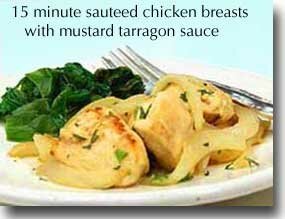healthy food tip and recipe
Today's Recipe
If you don't know what to serve for dinner tonight ...
Try this quick-and-easy recipe that combines the great tastes of chicken, Dijon mustard and tarragon to your Healthiest Way of Eating. Fresh herbs are a great way to enhance the taste of your meals and enjoy extra health-promoting nutrients as well.

Ingredients:
- 1 medium onion cut in half and sliced medium thick
- 5 medium cloves garlic, pressed
- 2 boneless, skinless chicken breasts, cut into 1-inch pieces
- 3 TBS Dijon mustard
- 1 TBS + 1/2 cup chicken broth
- 2 tsp honey
- 1 TBS chopped fresh tarragon (or 1 tsp dried tarragon)
- 2 TBS chopped fresh parsley (or 2 tsp dried parsley)
- salt and white pepper to taste
- Slice onion and press garlic and let sit for 5-10 minutes to bring out their hidden health benefits.
- Heat 1 TBS broth in a 10-12 inch stainless steel skillet. Healthy Saute onion in broth over medium heat for 2 minutes.
- While onions are sauteeing, cut chicken into pieces. Add chicken pieces and continue to saute for another 3 minutes, stirring frequently to seal chicken on all sides. Add garlic and continue to saute for another minute.
- Add mustard, 1/2 cup broth, and honey. Mix thoroughly and simmer uncovered for about 7-8 minutes on medium-high heat stirring occasionally to cook chicken evenly. This will also reduce sauce.
- While chicken is cooking, chop herbs and add at end with salt and pepper to taste.
- Mediterranean Swiss Chard
In-Depth Nutritional Profile for 15-Minute Sautéed Chicken Breasts with Mustard and Tarragon
Healthy Food Tip
Do blueberries still provide strong antioxidant support after they have been frozen?
Yes, even after blueberries have been frozen, they can provide you with excellent antioxidant support. It's important, of course, for your blueberries to be high quality before they are frozen, and for this reason, I recommend organically grown blueberries that are firm and lively colored when purchased. Avoid blueberries that are dull in color or appear soft and watery. If purchased in a container, I recommend that you gently shake it to make sure that the blueberries are firm enough to move freely and independently.
I encourage you to pay special attention to the color of your blueberries because a large part of that color comes from the anthocyanins (antioxidant phytonutrients) in the berries. There's good research showing very little loss of anthocyanins after freezing of healthy, ripe berries so you'll hardly be losing any of these unique antioxidants if you properly freeze high-quality fresh berries.
For other antioxidant nutrients, the loss due to freezing varies from about 10-40%. You'll lose less than 20% of your berries' vitamin E, lutein, zeaxanthin, and beta-carotene from freezing, and that's plenty of reason to take advantage of freezing as a convenient way to enjoy blueberries even when they are out-of-season. The amount of vitamin C lost during freezing can vary widely and can be substantial, but I still recommend that you treat freezing as a very acceptable step when it comes to blueberries. While fresh blueberries still rank highest on my recommendation list, all of the trade-offs involved with frozen blueberries seem worthwhile to me. I would consider that you'd still be following the Healthiest Way of Eating if you go the frozen route when fresh berries are not available.

No comments:
Post a Comment